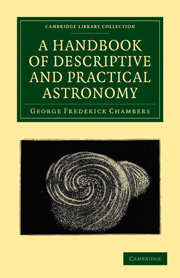Book contents
- Frontmatter
- PREFACE
- SUPPLEMENT
- Contents
- LIST OF ILLUSTRATIONS
- PRINCIPAL AUTHORITIES
- Errata
- A Handbook of Descriptive and Practical Astronomy
- BOOK I A SKETCH OF THE SOLAR SYSTEM
- BOOK II ECLIPSES AND THEIR ASSOCIATED PHENOMENA
- CHAPTER I GENERAL OUTLINES
- CHAPTER II ECLIPSES OF THE SUN
- CHAPTER III THE TOTAL ECLIPSE OF THE SUN OF JULY 28, 1851
- CHAPTER IV THE ANNULAR ECLIPSE OF THE SUN OF MARCH 14–15. 1858
- CHAPTER V THE TOTAL ECLIPSE OF THE SUN OF JULY 18, 1860
- CHAPTER VI HISTORICAL NOTICES
- CHAPTER VII ECLIPSES OF THE MOON
- CHAPTER VIII SUGGESTIONS FOR OBSERVING ANNULAR ECLIPSES OF THE SUN
- CHAPTER IX TRANSITS OF THE INFERIOR PLANETS
- BOOK III THE TIDES
- CHAPTER I
- CHAPTER II
- BOOK IV MISCELLANEOUS ASTRONOMICAL PHENOMENA
- BOOK V COMETS
- BOOK VI CHRONOLOGICAL ASTRONOMY
- BOOK VII THE STARRY HEAVENS
- BOOK VIII ASTRONOMICAL INSTRUMENTS
- BOOK IX A SKETCH OF THE HISTORY OF ASTRONOMY
- BOOK X METEORIC ASTRONOMY
- APPENDICES
- INDEX TO SUBJECTS
- INDEX TO NAMES
- Plate section
- Frontmatter
- PREFACE
- SUPPLEMENT
- Contents
- LIST OF ILLUSTRATIONS
- PRINCIPAL AUTHORITIES
- Errata
- A Handbook of Descriptive and Practical Astronomy
- BOOK I A SKETCH OF THE SOLAR SYSTEM
- BOOK II ECLIPSES AND THEIR ASSOCIATED PHENOMENA
- CHAPTER I GENERAL OUTLINES
- CHAPTER II ECLIPSES OF THE SUN
- CHAPTER III THE TOTAL ECLIPSE OF THE SUN OF JULY 28, 1851
- CHAPTER IV THE ANNULAR ECLIPSE OF THE SUN OF MARCH 14–15. 1858
- CHAPTER V THE TOTAL ECLIPSE OF THE SUN OF JULY 18, 1860
- CHAPTER VI HISTORICAL NOTICES
- CHAPTER VII ECLIPSES OF THE MOON
- CHAPTER VIII SUGGESTIONS FOR OBSERVING ANNULAR ECLIPSES OF THE SUN
- CHAPTER IX TRANSITS OF THE INFERIOR PLANETS
- BOOK III THE TIDES
- CHAPTER I
- CHAPTER II
- BOOK IV MISCELLANEOUS ASTRONOMICAL PHENOMENA
- BOOK V COMETS
- BOOK VI CHRONOLOGICAL ASTRONOMY
- BOOK VII THE STARRY HEAVENS
- BOOK VIII ASTRONOMICAL INSTRUMENTS
- BOOK IX A SKETCH OF THE HISTORY OF ASTRONOMY
- BOOK X METEORIC ASTRONOMY
- APPENDICES
- INDEX TO SUBJECTS
- INDEX TO NAMES
- Plate section
Summary
Every inhabitant of a maritime country like Great Britain is more or less familiar with the phenomena now under our consideration, but beyond knowing the general fact, that the Moon has something to do with the tides, their physical history is not so well understood as it ought to be.
The phenomena of the tides are very frequently attributed to the attraction of the Moon, whereby the waters of the ocean are drawn towards that side of the Earth on which our satellite happens to be situated; in fact, that it is high water when the Moon is on or near the meridian of the place of observation.
This, though to a certain extent true, by no means adequately represents the facts of the case, for high water is not only produced on that side of the Earth immediately under the Moon, but also on the opposite side at the same time. The two tides are therefore separated from each other by 180°, or by a space equal to half the circumference of the globe. The diurnal rotation of the Earth, causing every portion of its surface to pass successively under the tidal waves, in about 24h., it follows that there are everywhere 2 tides daily, with an interval of about 12 hours between each; whereas, if the common supposition were correct, there would be only.
- Type
- Chapter
- Information
- A Handbook of Descriptive and Practical Astronomy , pp. 148 - 152Publisher: Cambridge University PressPrint publication year: 2010First published in: 1861

